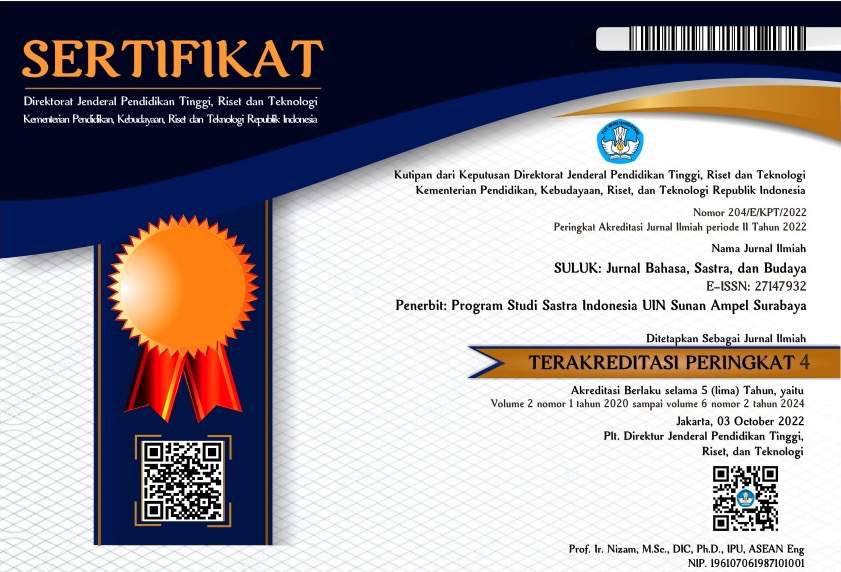Beauty Standard as a Construction of Woman Objectification in Trisha R. Thomas’s Nappily Ever After
DOI:
https://doi.org/10.15642/suluk.2022.4.2.157-168Keywords:
beauty standard, feminism, woman objectification, Nappily Ever After, Naomi WolfAbstract
The study aimed to depict how the beauty standards construct female objectification in Nappily Ever After and to analyze how the main character struggled toward beauty standards in the Nappily Ever After novel. This study is sought with qualitative methods to reveal the novel's issue. This study applied the theory of beauty myth from Naomi Wolf. The result of the study found that the beauty ideal is a woman who has straightened hair, brightening skin, a tall, slim body, and a pointed nose. Those highlighted Venus’s physical appearance which made her seem to be a typical woman and objectified her to conform to beauty standards. The study concluded that Venus internalized the beauty ideal which made her feel restricted by her looks and resulted in body image dissatisfaction. Venus struggled after she cut her hair which made her become an outcast in beauty image, being invisible by men, dismissal, and judged by people.
Downloads
References
Blood, S. K. (2005). Body Work: The Social Construction of Women’s Body Image. . New York: Routledge Taylor & Francis Group.
Chatman, S. B. (1980). Story and Discourse: Narrative Structure in Fiction and Film. New York: Cornell University Press.
Dworkin, A. R. (1974). Women Hunting: A Radical Look at Sexuality. New York: E. P. Dutton.
Emeksiz, G. I. (2021). The Stereotypical Representation of Females in Women’s Health Magazine’s Cosmetic Advertisements. Open Journal of Social Sciences, 09(09). https://doi.org/10.4236/jss.2021.99005
Featherstone, M. (2010). Body, Image and Affect in Consumer Culture. Body & Society, 16(1), 193–221. https://doi.org/10.1177/1357034X09354357
Fitria, S. (2020). Konstruksi Standar Kecantikan dalam Cerpen Fenghuang Karya Wendoko. Seminar Nasional Bahasa Dan Sastra Indonesia Universitas Pamulang, 1–7. Retrieved from http://openjournal.unpam.ac.id/index.php/SNS/article/view/7880
Furtuna, F. (2016). The Society’s Oppression in Constructing the Beauty Standard: A Feminist Reading of Scott Westerfeld ‘s Novel Ugliness (Universitas Airlangga). Retrieved from https://repository.unair.ac.id/57092/
Grosu-Rădulescu, L.-M. (2016). Objectification of Women and Violence in What the Body Remembers. Rupkatha Journal on Interdisciplinary Studies in Humanities, 8(1). Retrieved from https://rupkatha.com/what-body-remembers/
Halprin, S. (1995). Look at my Ugly Face: Myths and Musings on Beauty and other perilous obsessions with women’s appearance. . Boston: Viking.
Khoo, J. P. F. (2019). Resisting Beauty? Examining How Women Negotiate and Respond to Contemporary Beauty Ideals (University of York). Retrieved from https://etheses.whiterose.ac.uk/28898/1/Khoo_029102835_ThesisFinal.pdf
Kumar, D. (2019). Fashion and Beautification in India: Expression of Individuality. In Crafting Allure: Beauty, Culture and Identity. https://doi.org/10.1163/9781848882997_003
MacKay, M. (2011). The Cambridge Introduction to the Novel. Cambridge: Cambridge University Press.
Mim, M. B., & Tabassum, M. (2022). A critical study on female roles in television commercials of Bangladesh. Informasi, 51(2). https://doi.org/10.21831/informasi.v51i2.42903
Padmanugraha, A. S. (2015). Woman’s Values In Society As Reflected In Marge Piercy’s “Barbie Doll.” Diksi, 14(1). https://doi.org/10.21831/diksi.v14i1.6547
Patton, M. Q. (2002). Qualitative Research & Evaluation Methods. Saint Paul: The SAGE Publishing.
Putri, L. A. (2020). Objectification Suffered by Black Woman in Suzan-Lori Parks’ Venus (Universitas Islam Negeri Maulana Malik Ibrahim Malang). Retrieved from http://etheses.uin-malang.ac.id/18692/
Ribó, I. (2020). Prose Fiction: An Introduction to the Semiotics of Narrative. Retrieved from https://books.openedition.org/obp/12094
Sharma, S., & Bumb, A. (2021). Role Portrayal of Women in Advertising: An Empirical Study. Journal of International Women’s Studies, 22(9). Retrieved from https://vc.bridgew.edu/jiws/vol22/iss9/16/
Sherrow, V. (2021). For Appearance’ Sake: The Historical Encyclopedia of Good Looks, Beauty and Grooming. Westport: Oryx Press.
Sorokowski, P. (2010). Did venus have long legs? beauty standards from various historical periods reflected in works of art. Perception, 39(10). https://doi.org/10.1068/p6621
Thomas, T. R. (2001). Nappily Ever After. United States: Crown.
Vela, D. A. (2015). The Portrayal of Beauty Myth in Me Vs High Heels Film By Pingkan Utari: Femisism Analysis (Universitas Airlangga). Retrieved from https://repository.unair.ac.id/14623/
Wolf, N. (2002). The Beauty Myth . New York: Harper Collins.
Zarrinjooee, B., & Kalantarian, S. (2017). Women’s Oppressed and Disfigured Life in Margaret Atwood’s The Handmaid’s Tale. Advances in Language and Literary Studies, 8(1). https://doi.org/10.7575/aiac.alls.v.8n.1p.66
Downloads
Additional Files
Published
How to Cite
Issue
Section
License
Copyright (c) 2023 Heri Okta Sayekti, Sari Fitria

This work is licensed under a Creative Commons Attribution-ShareAlike 4.0 International License.
- Authors retain copyright and grant the journal right of first publication with the work simultaneously licensed under a Creative Commons Attribution ShareAlike License that allows others to share the work with an acknowledgment of the work's authorship and initial publication in this journal.
- Authors are able to enter into separate, additional contractual arrangements for the non-exclusive distribution of the journal's published version of the work (e.g., post it to an institutional repository or publish it in a book), with an acknowledgment of its initial publication in this journal.
- Authors are permitted and encouraged to post their work online (e.g., in institutional repositories, pre-print sites, or on their website) prior to and during the submission process, as it can lead to productive exchanges, as well as earlier and greater dissemination of published work.







